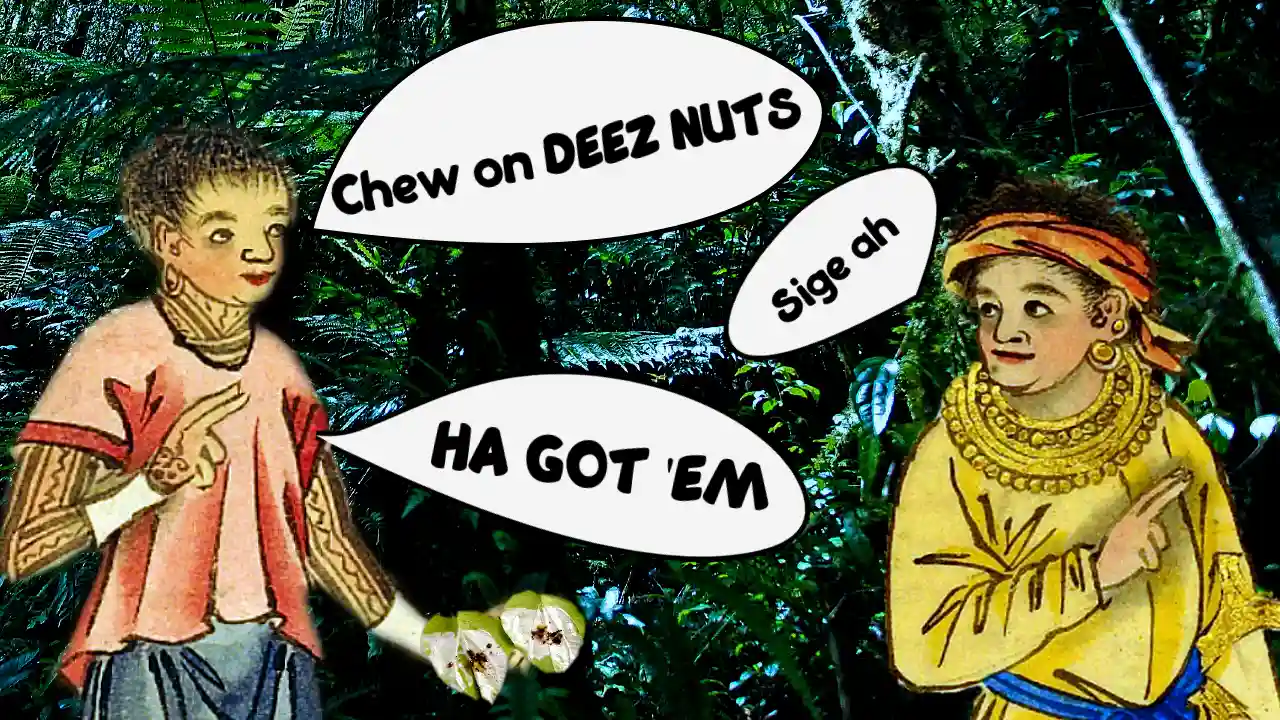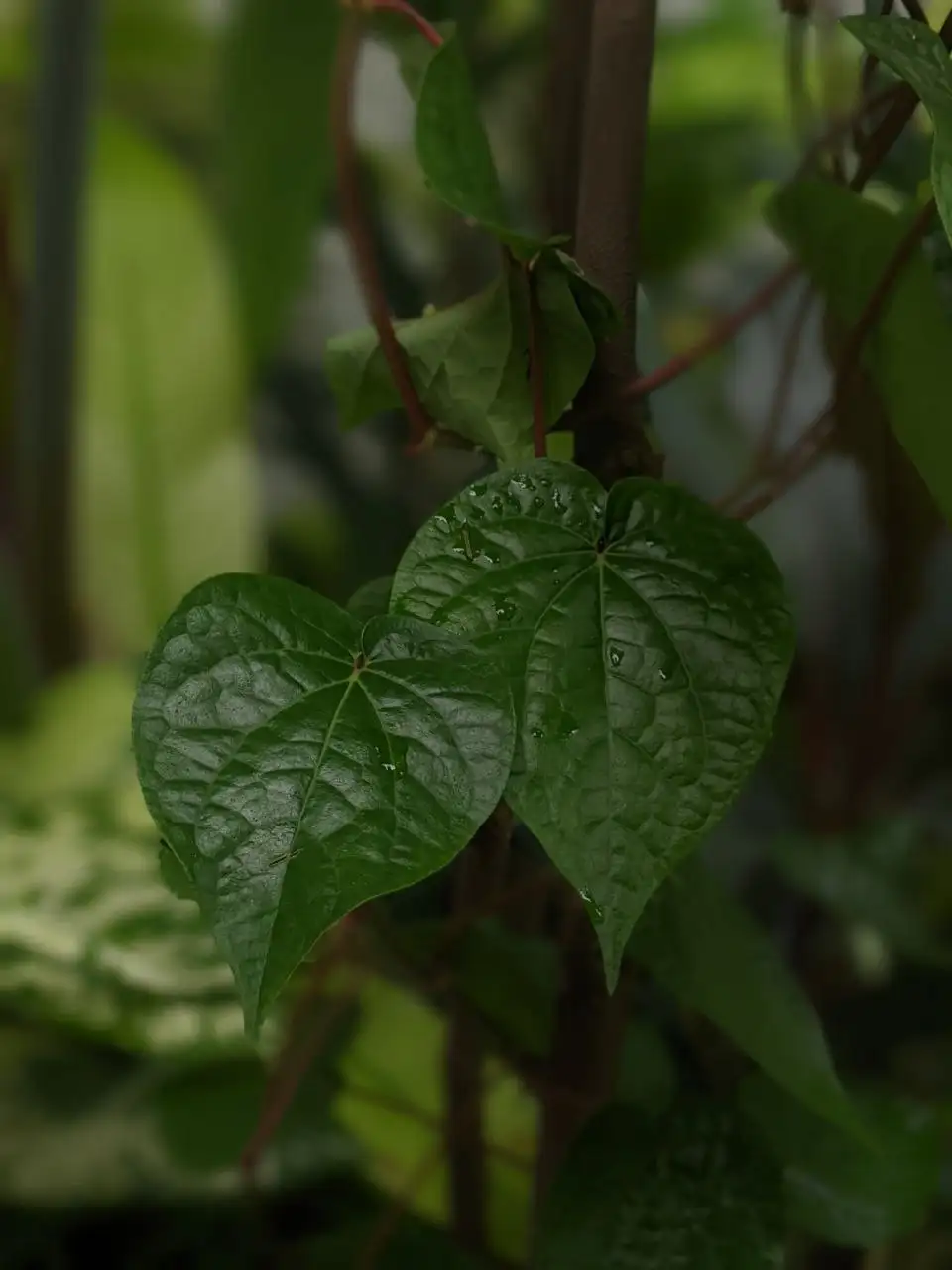
The Uses of Buyo and Bonga in Ancient Visayas

After seven long years of separation, Maria Clara and Crisostomo Ibarra were finally reunited, but there was a stupefying fog of disbelief that permeated the azotea where they found themselves alone facing each other. Thankfully, the power of small talk and “nonsensical trivialities” slowly swept the thick haze away, and once the blinds of distance faded the lovers immediately recovered the old magic that once drew their hearts close together. From thereon, Ibarra went on long protestations of yearning, even going as far saying that “Italy’s lovely skies”, “the landscape of Andalucia with its fragrant air”, and an evening cruise down the river Rhine all made him think of his beautiful beloved. But he wasn’t done yet. To emphatically prove his undying devotion, Ibarra issued from his wallet a packet of dried sage leaves, the very same leaves that Maria Clara once gave him when they were still young.1 The mere sight of these leaves triggered an outburst within them, setting unfettered all their suppressed, wild passions that they hurriedly went to an unoccupied room and made up for lost time by furiously making love.
Unfortunately, that last bit didn’t actually happen in the story. If it did, it would’ve made the story infinitely better. But it might have, had Jose Rizal written Noli me tangere as a historical novel set in precolonial Philippines, made the two lovers Bisaya, and had Maria Clara present the leaves instead. How could that be? In centuries past, Bisaya women used to give men a certain leaf that signified their consent to having sex. The leaf in question comes from the twining vine commonly called betel, from which it got its scientific name Piper betle. Locally, it is called buyo by the Bisaya. The Piper betle is a dioecious plant, that is, a kind of plant whose individual organisms can only produce either female or male flowers, never both. One of its most striking features is the shape of its leaves which is like a heart, and they can be as wide or even wider as a human palm, making it easy to distinguish out in the wild. All in all, a fitting symbol for heterosexual coupling. According to Fransisco Alcina, who spent three decades of his religious mission in the Visayas, the Bisaya offered buyo as “the first courtesy” to guests, especially to those with high rank. However, it had “evil uses”, and:
. . . entre otros usos malos de este buyo (aunque se dan y reciben en señal de amor y voluntad, y tal vez para reconciliarse de algunos sinsabores o pleitezuelos) es ser alcahuete; de modo que uno, o no puede o no se atreve a hablar claro con alguna mujer que pretende o desea, le envía a pedir buyos. Si no los da, es señal de que no tiene que esperar; si los da (y más si es de cierta hechura) es señal que consiente, y así va ya como a cosa hecha, aun sin haberse hablado.2
. . . among the evil uses of this buyo (although they are given and received as a sign of love and willingness, and perhaps to reconcile some displeasure and squabbles) is to pimp; so that one who either cannot or does not dare to speak plainly with some woman he wants and desires, he asks her for buyos. If she does not give them, it is a sign that he does not have to wait; if she gives them (and more so if it is of a certain quality) it is a sign that she consents, and so it goes like it was already done, even without having spoken.3
Before buyo could be offered, however, it needed to be assembled into a quid along with other materials. Alcina notes that the buyo was mainly used to wrap areca (Areca catechu) nuts called bonga by the Bisaya. These seeds were divided into three or more segments, depending on their individual sizes, and thereupon placed on the center of the buyo. The Bisaya then add crushed lime to the cut areca nuts, close the leaf and tie it with a knot, put it inside their mouths, and finally proceed with the “viciosa ocupación” of chewing the final article. The result? The mouths of those who use it become dreadful ("bocas fieras") because their tongues almost turn black and cracked ("lenguas casi negras y rajadas") and their lips turn bloody ("los labios almagrados").4 According to Alcina, the more affluent principales called the mixture buyo, while the rest of the Bisaya called it mam-un.5 In the 1711 Bisaya-Español dictionary of Matteo Sanchez, it is also referred to as mama.
All over the text, Alcina makes it clear that he has a brazen distaste for this “viciosa ocupación” thanks to the colourful adjectives he employs in writing about it. But underneath his righteous contempt is an undeniably curious spirit driven to know why things are the way they are and explain why they are so, for it is from him that we also learn of the possible reasons why the buyo was valued by the Bisaya and was made the leaf of choice for sexual solicitation and invitation.

Leaves of buyo.
Under normal circumstances, it was the women of the household who were tasked to offer buyo as a gesture of hospitality. The main matriarch handed them out when high-ranking personalities came to visit. Guests of no remark received them from female slaves.6 Already we see an implicit message of acceptance embedded in the act of giving buyo, and this is perhaps what makes it a clear and viable signal for sexual consent: the presence of those who receive buyo is welcomed, and by extension, those who seek sex is invited to do so when it is offered to them. Moreover, the buyo has a cosmetic component that caters to Bisaya visual preferences. Though having darkened teeth, gums, and lips may not look that alluring nowadays, and will most likely lead to an appointment with a dentist rather than being invited on a romantic night out, for the ancient Bisaya and their nearby Southeast Asian cousins these were the hallmarks of charm and allure. In his 1923 classic Malay Poisons and Charm Cures, British physician John Desmond Gimlette reports that in British Malaya the resultant “hue being communicated” after chewing buyo “is esteemed ornamental”, and that the areca, betel, and lime are the “mode of conveying philtres, or love charms.”7 One possible explanation emerges from this realisation: women give buyo to ensure that their partners remain or become attractive during sex. This notion is somewhat reinforced by the fact that chewing buyo slightly alleviated bad breath ("corrige el aliento").8
But more than just a key to satisfy the pleasures of the flesh, buyo was also used in keeping both body and mind fit and healthy. It was an important item in local materia medica, used to treat certain diseases and discomforts of the inner constitution. For example, according to Alcina, topical application with mild pressure of the buyo leaf on the forehead relieved migraines. Boiled bonga seeds calmed agitated bowels.9 As can be seen, it is clear that the act of giving buyo carried with it a constellation of meanings premised under the ethos of accommodation not limited to household hospitality or sex, but it encompassed healing as well. Unwelcome guests receive none of it during their visit. Sexual prospects deemed insufficient or unattractive are refused from receiving it. Yet, in both cases, they can still be offered buyo if they are enduring certain ills, regardless of their initial intentions. Sad is the man unable to control his tears after rejection, sadder still if his digestive tract joins in on letting loose.
Alcina acknowledges that there are certain benefits to be derived from using buyo and bonga, but only if they are done in moderation.10 And in this regard, his advice is profoundly prescient. Recent research has shown that not only is buyo (the quid) highly addictive, but it is also classified as a group I carcinogen. What this means is that it is known to cause cancers in humans, the most prevalent of which are cancers of the “esophagus, liver, pancreas, larynx, and lungs”.11 So Alcina is within reason to call the practice of chewing the quid viciosa, as it can slowly develop deteriorating agents in the body.
Among the many applications of the aforementioned plants, one stands out to Alcina as being truly vicious regardless of the frequency of use, and that is as abortifacient. He only hints at the fact dismissively, saying “y aun usan de ella las mujeres para otros usos que, por poco decentes, dejo de contar” (“women use them for other purposes that are quite indecent, which I will not report”).12 It is rather exasperating that he refused to detail its use as such after having written so much about it already, because in doing so he has kept from us an opportunity to understand how ancient knowledge was passed down from one generation to another, and more important, from women to other women regarding their reproductive health. Fortunately, we can infer their method by analysing how close neighbours used it as such. Gimlette notes that Malaya women used shoots of the areca as an ingredient when making a concoction that induces abortion.13 This technique wouldn’t be out of place in the context of ancient Bisaya herbology, so it is possible that Bisaya women also followed the same procedure.
Whichever was discovered first, the constipative or abortive properties of bonga, it is impossible to know, but one thing is clear: the ancient Bisaya had the foresight to use the same plant to deliberately act on the other organs found on the same region of the body. Close to the bowels is the uterus, and since the bonga acted on one, it probably made sense to the Bisaya that it could also cause effects on the other. In the first place, how could they have discovered the specific medicinal applications of certain plants when they were surrounded by such abundance? This leaves us room to speculate, and one safe assumption is that many experimentations must have taken place where they tested different mixtures and measurements to come up with the perfect recipe, using all the available tools and botanical savvy at their disposal. Not all were successful, leading to multiple complications and even fatalities. Those that they’ve found to work for their needs they preserved by passing the knowledge down the generations. Many still exist today, although in highly modified forms.
Suffice it to say, buyo and its components enjoyed a special importance in Bisaya life, especially for women as it acted as an extension of their choice and consent. By simply not showing it when expected, they can already express their sexual and/or social disagreements, so unwanted guests and penises are both denied entry even without a single word uttered. It provides an assurance that the pleasures of sex can only be enjoyed with those who they gave their consents to. This feature alone makes the buyo an especially powerful commodity. And when it led to pregnancy, bonga provided an easy solution to halt fetal development early on, so one can still go about their life without being burdened by later childbirth and care. In this way, problems are minimised or altogether avoided. Now, if only Doña Tia Alba were Bisaya and had the power of buyo to deny Padre Damaso his malicious motives, the Noli would have been truly “touch me not”. Alas, they weren’t, and so Maria Clara was born, who, later in her life, also suffered the same fate as her mother, ruined by the dictates of men. Is the idea of women being able to disagree with what men have to say difficult to chew? For the ancient Bisaya, it wasn’t. That says a lot on who really was and is still engaged in vicious occupations.
-
Jose Rizal, Noli Me Tangere, ed. Raul Locsin, trans. Ma. Soledad Lacson-Locsin (Makati: The Bookmark, Inc., 2006), 57-61. ↩︎
-
Ignacio Fransisco Alcina, History of the Bisayan People in the Philippine Islands, vol. 1, eds. and trans. Cantius Kobak and Lucio Guitérrez (Manila: UST Publishing House, 2002), 400. ↩︎
-
Translation by the author. Unless otherwise stated, all subsequent Spanish to English translations are by the author as well. The volume from where the Alcina quote is taken provides an English translation, but it euphemises certain words. For example, alcahuete is translated as “to procure” instead of “to pimp”, and in the passage above, the latter is closer to what Alcina meant. ↩︎
-
Translation note: Almagrados is a word that doesn’t have a single definitive meaning. In many historical texts, it is used metaphorically to describe things that are bloodstained, bloody, darkened, or generally terrible to look at. ↩︎
-
Ibid., 396-398. ↩︎
-
Ibid., 400. ↩︎
-
John Desmond Gimlette, Malay Poisons and Charm Cures (London: J. & A. Churchill, 1923), 205-206. ↩︎
-
Alcina, History of the Bisayan People, 398. ↩︎
-
Ibid., 402. ↩︎
-
Ibid., 398. ↩︎
-
I. A. Athukorala, W. M. Tilakaratne, & R. D. Jayasinghe, “Areca Nut Chewing: Initiation, Addiction, and Harmful Effects Emphasizing the Barriers and Importance of Cessation,” Journal of Addiction 2021 (2021): 2. https://doi.org/10.1155/2021/9967097. ↩︎
-
Alcina, History of the Bisayan People, 402. ↩︎
-
Gimlette, Malay Poisons, 206. ↩︎
Did you like what you read? Then consider subscribing to the Bibliotikal newsletter to get immediate alerts on new posts, local history news, and activity announcements.
Share on: